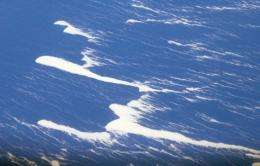An area of floating pumice 250 nautical miles in length and 30 nautical miles wide in the South Pacific ocean. A huge cluster of floating volcanic rocks covering almost 26,000 square kilometres (10,000 square miles) has been found drifting in the Pacific.
A huge cluster of floating volcanic rocks covering almost 26,000 square kilometres (10,000 square miles) has been found drifting in the Pacific, the New Zealand navy said Friday.
The strange phenomenon, which witnesses said resembled a polar ice shelf, was made up of lightweight pumice expelled from an underwater volcano, the navy said.
An air force plane spotted the rocks on Thursday about 1,000 kilometres (600 miles) offshore from New Zealand and warned a navy warship that it was heading towards them.
Lieutenant Tim Oscar said that while he knew his ship the HMNZS Canterbury was in no danger from the pumice, which is solidified lava filled with air bubbles, it was still "the weirdest thing I've seen in 18 years at sea".
"As far ahead as I could observe was a raft of pumice moving up and down with the swell," he said.
In this Thursday, Aug. 9, 2012 photo released by New Zealand Defence Force, pumice rocks are shown at an unidentified location after the rocks were collected from an area of floating pumice near South West of Raoul island, off New Zealand's coast. A mass of small volcanic rocks nearly the size of Belgium was discovered floating off the coast of New Zealand. The stretch of golf-ball-size pumice rocks was first spotted this week by a New Zealand air force plane about 1,000 kilometers (620 miles) northeast of Auckland. Scientists said the rocks likely spewed up in an eruption by an underwater volcano. (AP Photo/New Zealand Defence Force, Nicole Munro) EDITORIAL USE ONLY
"The rock looked to be sitting two foot (half a metre) above the surface of the waves and lit up a brilliant while colour in the spotlight. It looked exactly like the edge of an ice shelf."
Scientists aboard the ship said the pumice probably came from an underwater volcano called Monowai, which has been active recently.
They said the phenomenon was unrelated to increased volcanic activity in New Zealand this week, including an eruption at Mount Tongariro that sent an ash cloud 20,000 feet into the atmosphere.
(c) 2012 AFP























